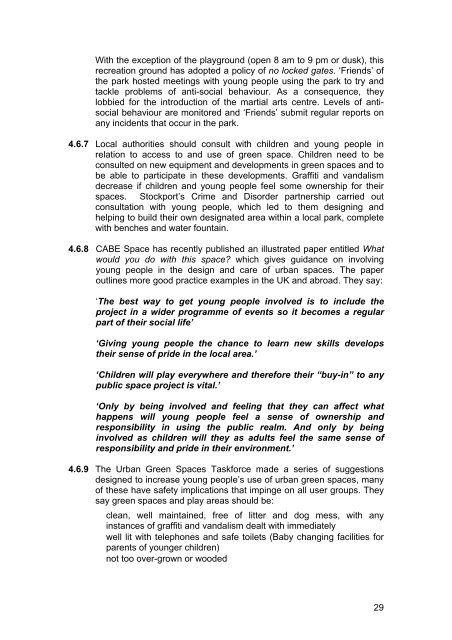Anti social behaviour in green spaces - Newcastle City Council
Anti social behaviour in green spaces - Newcastle City Council
Anti social behaviour in green spaces - Newcastle City Council
You also want an ePaper? Increase the reach of your titles
YUMPU automatically turns print PDFs into web optimized ePapers that Google loves.
With the exception of the playground (open 8 am to 9 pm or dusk), this<br />
recreation ground has adopted a policy of no locked gates. ‘Friends’ of<br />
the park hosted meet<strong>in</strong>gs with young people us<strong>in</strong>g the park to try and<br />
tackle problems of anti-<strong>social</strong> <strong>behaviour</strong>. As a consequence, they<br />
lobbied for the <strong>in</strong>troduction of the martial arts centre. Levels of anti<strong>social</strong><br />
<strong>behaviour</strong> are monitored and ‘Friends’ submit regular reports on<br />
any <strong>in</strong>cidents that occur <strong>in</strong> the park.<br />
4.6.7 Local authorities should consult with children and young people <strong>in</strong><br />
relation to access to and use of <strong>green</strong> space. Children need to be<br />
consulted on new equipment and developments <strong>in</strong> <strong>green</strong> <strong>spaces</strong> and to<br />
be able to participate <strong>in</strong> these developments. Graffiti and vandalism<br />
decrease if children and young people feel some ownership for their<br />
<strong>spaces</strong>. Stockport’s Crime and Disorder partnership carried out<br />
consultation with young people, which led to them design<strong>in</strong>g and<br />
help<strong>in</strong>g to build their own designated area with<strong>in</strong> a local park, complete<br />
with benches and water founta<strong>in</strong>.<br />
4.6.8 CABE Space has recently published an illustrated paper entitled What<br />
would you do with this space? which gives guidance on <strong>in</strong>volv<strong>in</strong>g<br />
young people <strong>in</strong> the design and care of urban <strong>spaces</strong>. The paper<br />
outl<strong>in</strong>es more good practice examples <strong>in</strong> the UK and abroad. They say:<br />
‘The best way to get young people <strong>in</strong>volved is to <strong>in</strong>clude the<br />
project <strong>in</strong> a wider programme of events so it becomes a regular<br />
part of their <strong>social</strong> life’<br />
‘Giv<strong>in</strong>g young people the chance to learn new skills develops<br />
their sense of pride <strong>in</strong> the local area.’<br />
‘Children will play everywhere and therefore their “buy-<strong>in</strong>” to any<br />
public space project is vital.’<br />
‘Only by be<strong>in</strong>g <strong>in</strong>volved and feel<strong>in</strong>g that they can affect what<br />
happens will young people feel a sense of ownership and<br />
responsibility <strong>in</strong> us<strong>in</strong>g the public realm. And only by be<strong>in</strong>g<br />
<strong>in</strong>volved as children will they as adults feel the same sense of<br />
responsibility and pride <strong>in</strong> their environment.’<br />
4.6.9 The Urban Green Spaces Taskforce made a series of suggestions<br />
designed to <strong>in</strong>crease young people’s use of urban <strong>green</strong> <strong>spaces</strong>, many<br />
of these have safety implications that imp<strong>in</strong>ge on all user groups. They<br />
say <strong>green</strong> <strong>spaces</strong> and play areas should be:<br />
clean, well ma<strong>in</strong>ta<strong>in</strong>ed, free of litter and dog mess, with any<br />
<strong>in</strong>stances of graffiti and vandalism dealt with immediately<br />
well lit with telephones and safe toilets (Baby chang<strong>in</strong>g facilities for<br />
parents of younger children)<br />
not too over-grown or wooded<br />
29

















